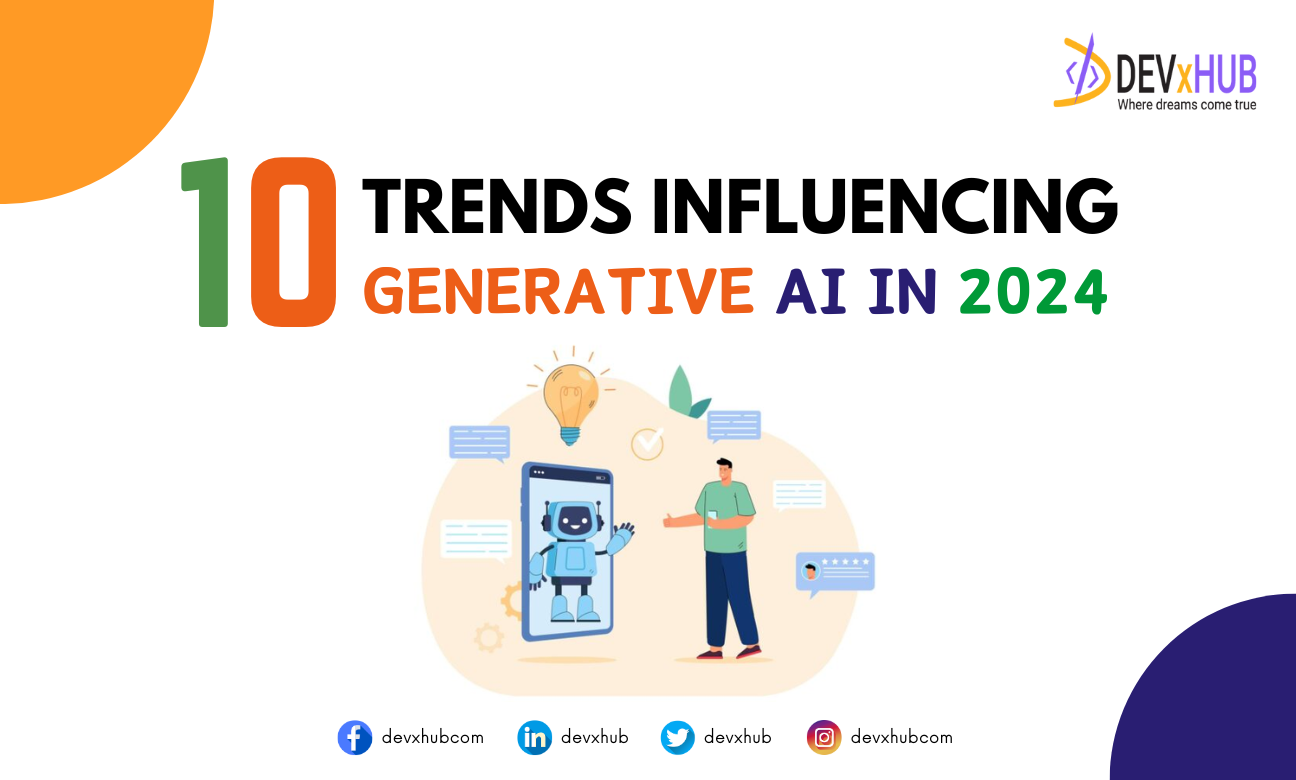Blog - 10 Trends Influencing Generative AI in 2024
Generative AI, the branch of artificial intelligence dedicated to creating new content such as text, images, and music, is experiencing rapid advancements. As we navigate through 2024, several key trends are shaping the development and application of this transformative technology. From enhanced model capabilities and multimodal AI systems to personalized content generation and ethical considerations, these trends are driving innovations that impact various industries.
The integration of GenAI with emerging technologies like augmented reality (AR) and virtual reality (VR), alongside its growing role in scientific research and creative arts, highlights its expanding influence. In this dynamic landscape, understanding the major trends influencing GenAI is crucial for businesses, researchers, and policymakers aiming to harness its potential responsibly and effectively. This introduction explores the ten pivotal trends set to define Generative AI in 2024, offering insights into the future of this rapidly evolving field.
1. Enhanced Model Capabilities and Efficiency
In 2024, one of the most significant trends is the continuous improvement in the capabilities and efficiency of generative models. Advanced architectures like GPT-4 and beyond are enabling models to produce more accurate and contextually relevant content. Researchers are focusing on optimizing these models to reduce computational requirements and energy consumption, making AI more accessible and sustainable.
The enhancements in model capabilities are driven by the need for more sophisticated and nuanced content generation. This involves not only increasing the size of the models but also making them more efficient in terms of processing power and memory usage. Techniques such as knowledge distillation, where smaller models are trained to mimic the performance of larger models, and sparsity, which reduces the number of active parameters during inference, are becoming more prevalent. These advancements are crucial in making GenAI scalable and economically viable for widespread use.
2. Multimodal AI Systems
Multimodal AI, which integrates multiple types of data (text, image, audio, video), is becoming more prevalent. These systems can understand and generate content across different modalities, leading to more versatile applications. For instance, an AI that can analyze an image, generate a descriptive text, and then create a relevant audio narration exemplifies the power of multimodal AI.
The ability to process and generate multimodal content opens up new possibilities in areas such as virtual assistants, where an AI can interact with users through text, voice, and visual cues. In healthcare, multimodal AI can combine patient data, medical images, and clinical notes to assist in diagnosis and treatment planning. The development of these systems involves sophisticated neural network architectures that can seamlessly integrate and interpret data from various sources, providing a more holistic and accurate understanding of complex scenarios.
3. Personalized Content Generation
Personalization is a critical trend, with GenAI increasingly used to create tailored content for individual users. This is particularly impactful in marketing, entertainment, and education, where personalized recommendations and content can significantly enhance user engagement and satisfaction. Algorithms are becoming adept at learning user preferences and generating content that meets specific needs and tastes.
In marketing, personalized content can lead to more effective advertising campaigns, where messages are tailored to individual consumer profiles based on their behavior and preferences. In education, personalized learning plans created by GenAI can adapt to the pace and style of each student, making learning more effective and enjoyable. This trend is supported by advancements in data analytics and machine learning, which allow AI systems to continuously learn and adapt to user feedback, ensuring that the content remains relevant and engaging.
4. Ethical and Responsible AI
As GenAI becomes more influential, ethical considerations are paramount. Issues such as bias, misinformation, and the ethical use of generated content are being actively addressed. There is a growing emphasis on developing frameworks and guidelines to ensure that AI is used responsibly. Researchers and policymakers are collaborating to create standards that promote fairness, transparency, and accountability in AI applications.
Efforts to mitigate bias in AI involve improving the diversity and representativeness of training data and developing algorithms that can identify and correct biases. Addressing misinformation requires robust mechanisms for verifying the accuracy of generated content and identifying potential sources of false information. Ethical guidelines are being established to govern the use of GenAI in sensitive areas such as law enforcement, healthcare, and finance, where the stakes are high and the potential for harm is significant. These initiatives aim to build public trust in AI technologies and ensure that they are used in ways that benefit society as a whole.
5. Real-time Applications
The demand for real-time applications of GenAI is rising. From instant language translation to real-time content moderation and dynamic customer service interactions, the ability to generate content on-the-fly is transforming various industries. This trend is supported by advances in processing power and the development of more efficient algorithms.
Real-time language translation powered by GenAI is breaking down language barriers in global communication, enabling instant and accurate translations in multilingual conversations. In content moderation, AI systems can swiftly identify and address inappropriate or harmful content, ensuring safer online environments. Dynamic customer service interactions facilitated by GenAI involve real-time responses to customer inquiries, providing personalized assistance and improving customer satisfaction. These applications require highly optimized algorithms capable of processing large volumes of data and generating responses with minimal latency, ensuring a seamless user experience.
6. Integration with AR and VR
Augmented Reality (AR) and Virtual Reality (VR) are creating new opportunities for GenAI. By integrating AI-generated content with AR and VR environments, developers can create more immersive and interactive experiences. This fusion is particularly evident in gaming, virtual tours, and remote collaboration tools, where AI enhances the realism and interactivity of virtual worlds.
In gaming, AI-generated characters and environments can adapt to player actions in real-time, creating dynamic and engaging gameplay experiences.
Virtual tours enhanced by GenAI can provide personalized and interactive guides, offering users a more informative and enjoyable experience. In remote collaboration, AI can facilitate virtual meetings by generating real-time translations, summaries, and interactive elements that enhance communication and productivity. The integration of GenAI with AR and VR is pushing the boundaries of what is possible in digital experiences, making them more engaging and lifelike.
7. Creative and Artistic Applications
GenAI is making significant inroads into the creative arts. AI-generated music, visual art, and literature are gaining recognition and acceptance. Artists and creators are using AI as a tool to push the boundaries of their work, exploring new styles and techniques. This trend is democratizing creativity, allowing more people to experiment with artistic expression through AI.
AI-generated music can compose new pieces in various styles, providing inspiration and collaboration opportunities for musicians. In visual art, AI can generate new artworks, assist in the creation of complex designs, and even restore damaged pieces. AI in literature can help writers by suggesting plot ideas, generating dialogue, and even creating entire stories. These creative applications of GenAI are not only expanding the possibilities for professional artists but also making creative expression more accessible to amateurs and enthusiasts.
8. AI in Scientific Research
Generative AI is proving to be a valuable asset in scientific research. AI models are being used to generate hypotheses, simulate experiments, and analyze vast datasets. This trend is accelerating discoveries in fields such as drug development, climate science, and genomics. AI-driven research tools are helping scientists to explore new frontiers more efficiently and effectively.
In drug development, GenAI can generate molecular structures with potential therapeutic properties, speeding up the discovery of new medications. Climate scientists are using AI to model complex environmental systems and predict the impacts of climate change with greater accuracy. In genomics, AI is helping to decode the complexities of genetic data, leading to advancements in personalized medicine and disease prevention. The integration of GenAI in scientific research is not only enhancing the speed and accuracy of discoveries but also enabling researchers to tackle problems that were previously considered intractable.
9. Collaborative AI
Collaboration between humans and AI is becoming more seamless. AI tools are increasingly being designed to work alongside humans, augmenting their capabilities and enabling more productive interactions. This trend is evident in areas like content creation, where AI assists writers and designers, and in customer service, where AI supports human agents in providing better service.
In content creation, AI can generate initial drafts, suggest improvements, and provide creative ideas, allowing human creators to focus on refining and personalizing the content. In customer service, AI-powered chatbots can handle routine inquiries, freeing up human agents to address more complex issues. Collaborative AI systems are designed to enhance human productivity and creativity, providing tools that complement rather than replace human skills. This synergy between humans and AI is leading to more efficient and innovative outcomes across various fields.
10. Regulatory and Policy Developments
The rapid advancement of GenAI has prompted regulatory bodies to take a closer look at its implications. Governments and organizations are developing policies to govern the use of AI, addressing issues such as data privacy, intellectual property, and the societal impact of AI-generated content. These regulations aim to balance innovation with protection, ensuring that the benefits of GenAI are realized responsibly.
Data privacy regulations are being updated to address the unique challenges posed by AI, ensuring that personal data used in training AI models is handled securely and ethically. Intellectual property laws are evolving to define the ownership and rights associated with AI-generated content, providing clarity for creators and users. Policymakers are also considering the societal impacts of AI, such as job displacement and the digital divide, and are developing strategies to mitigate these effects. By establishing a robust regulatory framework, governments and organizations aim to foster a responsible and inclusive AI ecosystem that benefits society as a whole.
Conclusion
Generative AI is set to transform multiple sectors in 2024, driven by advancements in model capabilities, multimodal systems, and real-time applications. Enhanced AI efficiency is enabling more sophisticated and contextually relevant content generation, while integration with AR and VR is creating immersive digital experiences. Personalized content generation is revolutionizing marketing, education, and entertainment by tailoring experiences to individual preferences.
The creative arts are being democratized by AI, empowering artists with new tools for expression. In scientific research, GenAI is accelerating discoveries in fields like drug development and climate science, providing new insights and efficiencies. Ethical and responsible AI use is critical, with efforts focused on addressing bias, misinformation, and ethical considerations.
Regulatory and policy developments are shaping the use of AI, ensuring data privacy, intellectual property protection, and societal impact mitigation. Collaborative AI, which enhances human capabilities, is fostering innovation and productivity across various domains.
As we move forward, it is essential to harness GenAI’s potential responsibly, ensuring that its benefits are equitably distributed and its risks mitigated. By staying attuned to these trends, we can leverage GenAI to create a future that is innovative, inclusive, and sustainable.
Related Posts
Categories
- App Development (2)
- Design (2)
- DEVxHUB (30)
- Digital Marketing (2)
- Guide (24)
- It Bangladesh (1)
- Logo design (1)
- Operating system (1)
- Personal Improvement (14)
- Planning (4)
- Project management (3)
- Social media (2)
- Software Development (5)
- Software Quality Assurance (8)
- Startups (1)
- Team work (1)
- UI UX (1)
- Web Development (6)
Main Tags
- 2024
- Android
- app development
- bangladesh
- content writing
- design
- devxhub
- Digital marketing
- Guide
- IOS
- It
- logo design
- Operating system
- Personal Improvement
- planning
- project management
- social media
- Software Development
- Software Quality Assurance
- software testing
- software testing types
- Startups
- Success
- team
- UI UX
- UI UX design
- VR
- Web Development















